

Spanish A Level requires students to show strong spoken skills, accurate grammar, and cultural knowledge of the Hispanic world. Many learners prepare with past papers, mark schemes, and classroom lessons, but the real progress comes when they practise Spanish in everyday life. Today, students also have access to a wide range of digital resources, such as online course materials and interactive tools, to support their A Level Spanish preparation.
This June, Sofía and Flora, two Italian friends, joined the Spanish Homestay Immersion Program (SHIP) in Valencia to prepare for their upcoming A Level examinations. At 17 and 15, they used the stay to revise key topics, expand vocabulary, and build confidence in conversation – all while living the culture they had only studied in class. Both students have a strong interest in language learning, and their passion for languages motivated them to fully immerse themselves in the experience. Their previous experience with other languages has broadened their cultural perspective and helped them appreciate the value of learning multiple languages.
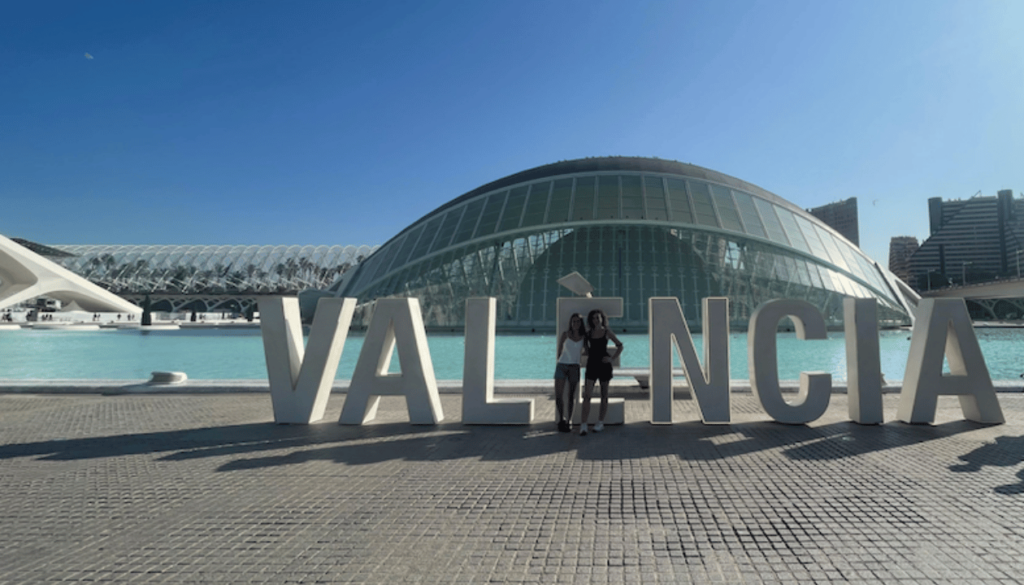
Our First Interaction
It was a real pleasure to host Sofía and her childhood friend, Flora, in my home in Gilet, Valencia, this June. Sofía (17) and Flora (15) are two Italian students who reunited through the Spanish Homestay Immersion Program (SHIP) to learn Spanish for A-level and boost their spoken language skills. Despite being from the same country, family circumstances have led them to live in different places – one in the United States and the other in Italy. However, distance has not weakened their bond. They share a passion for travel, culture, and language that keeps their friendship strong.

From our very first conversation, I discovered how truly interested they were in learning. Both girls started studying Spanish in secondary school (the equivalent of Spanish GCSE) and fell in love with the language. Over the past three years, they have traveled together to various French- and Spanish-speaking countries to attend immersion courses. These experiences allowed them to develop practical communication skills far beyond what a typical classroom can offer. They especially enjoy connecting with locals, discovering cultural heritage, and picking up everyday vocabulary wherever they go.
Their Objective
When they chose the Spanish Homestay Immersion Program (SHIP) in Valencia, their objective was clear: improve spoken Spanish in preparation for their upcoming A-level course exams. Spanish is a valuable subject choice at A Level, complementing other academic subjects and broadening future study and career opportunities.
They were excited about a full-immersion course that would take them out of their comfort zone and immerse them in the Hispanic world. SHIP offers exactly that – a unique opportunity to live and learn in a teacher’s home.
In addition to perfecting the language, Sofía and Flora could explore the local cuisine, participate in sports, and feel the Spanish regional identity up close. As their host tutor and teacher, I planned a personalised program covering everything from formal lessons to cultural adventures, all tailored to help them excel in their A-level Spanish course.
A Tailored Immersive Learning Plan
During Sofía and Flora’s stay, I designed a comprehensive learning plan to strengthen their Spanish proficiency and deepen their cultural understanding. The idea was to combine daily social interaction with structured study, creating the perfect environment for meaningful learning. With guidance and support, the girls engaged in constant practice that prepared them for both real-life conversations and their upcoming examinations.
We made sure to balance casual dialogues with focused lessons, ensuring all language skills were addressed – speaking, listening, reading, and writing, with a particular focus on challenging topics and exam techniques to maximize their progress. This holistic approach would develop not only their fluency but also the exam techniques needed for top marks in their A-level qualification.
Informal Conversation Sessions
One of the best parts of the homestay is that learning happens naturally all day long. I encouraged Sofía and Flora to converse in Spanish in a wide range of everyday situations. We chatted at home during family meals, on car journeys into Valencia, and even at gatherings with friends and neighbors.
Nothing was off-limits as a topic – from discussing the day’s plans to aspects of local culture and society. During a tennis game with my friend Tanja, for example, all the coaching and joking happened in Spanish.
These informal conversation sessions gave the girls real-world practice beyond any textbook or past papers. They grew more spontaneous and confident with each interaction, speaking Spanish as freely as they would in their native language.
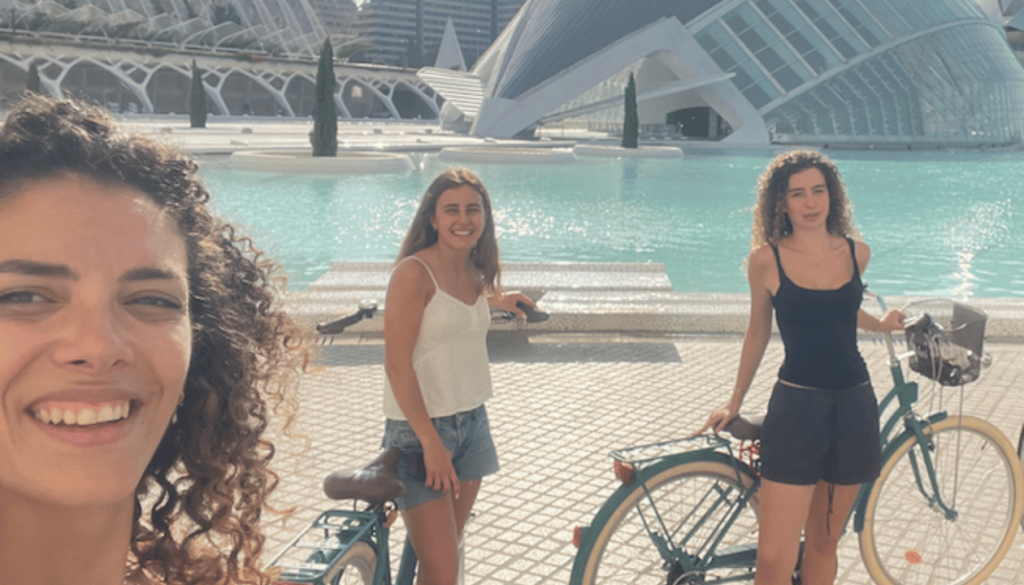
Formal Lessons: Grammar and Vocabulary Development
In the mornings, we set aside time for formal lessons to work on grammar, vocabulary, and other exam-specific skills. Using a variety of course materials (including the Spanish Express Verb Workbook and past A-level papers), we consolidated the grammatical foundation the girls had built at school. Their teachers back home had given them a solid start, so my role was to expand on that knowledge and push it to the next level.
We focused on complex areas of grammar that they would need for the A-level syllabus. This included a thorough revision of verb tenses in both the indicative and subjunctive moods. We practiced using connectors and transitional phrases to help them write longer, more coherent sentences for essays and translation tasks. These lessons helped the students better understand the complexities of Spanish grammar and how it is used in real contexts. Each lesson was tailored to topics from the A-level Spanish course, so the content felt relevant to what they might encounter in exams. We even tackled a sample A-level listening exam paper together to accustom them to the speed and format of the audio.
Oral and Written Exercises
Practice makes perfect, especially when preparing for important exams. I gave Sofía and Flora plenty of exercises to reinforce what we covered in lessons. For writing practice, they tackled short essays and translation challenges (Spanish to English and vice versa) to apply new vocabulary in context. We regularly simulated exam conditions for paper assignments – for instance, doing a mock A-level writing paper under timed conditions – which helped them manage time and stress.
Grammar Drills
Grammar drills were also a key component of our study routine. Using the Verb Workbook and other resources, the girls practiced a wide range of verb forms and tenses. They reviewed fundamentals like the present tense and present perfect, worked on tricky regular and irregular verbs, and mastered reflexive verbs and special structures like gustar. We went over past tenses (preterite, imperfect, and present perfect) and then moved on to future tenses (both simple and compound forms).
Conditional tenses (simple and compound) were practiced through fun hypothetical questions, which the girls enjoyed creating stories for. Finally, we dove into the essential subjunctive mood, integrating it into everyday scenarios so it became more natural for them. This structured grammar practice enabled Sofía and Flora to internalize rules and use them confidently in speech and writing. By the end of the program, their grasp of Spanish grammar had noticeably improved – something their school teachers and examiners would surely notice.
What Else?
Beyond grammar, I wanted to enrich their understanding of Spanish culture and themes, since language learning isn’t just about rules. We discussed topics drawn from the A-level Spanish syllabus, touching on both contemporary issues and historical perspectives.
For example, we talked about Spanish regional identity and what makes each region unique, from language differences to local traditions.
The girls were fascinated by Spain’s history and how it has shaped modern society. We even ventured into complex subjects like la política (political life), la convivencia (social coexistence) y los valores tradicionales (traditional values), since these are important sub themes for the A Level oral exam. I guided them through an individual research project style discussion as well – similar to the Independent Research Project they would undertake for their A-level speaking exam.
For this, they chose a cultural topic: the cultural heritage of Valencia and its festivals. Each girl explored different aspects, such as the history of Las Fallas, and delivered a formal presentation of her findings in Spanish. This exercise not only prepared them for the speaking assessment, but also gave them a deeper appreciation of the Hispanic society and the broader Hispanic world.
By tying our lessons to real cultural content, the girls gained a rich context for the language – literature, traditions, current events – far beyond what any one course or textbook alone could provide.
Throughout the week, I made sure to provide plenty of support and guidance. If a concept was challenging, we revisited it together. I also shared study tips, like how to effectively do vocabulary revision or practice listening with Spanish songs and videos. It was rewarding to see their dedication as learners. With each passing day, they became more confident and exam-ready.
By the end of the homestay, I could tell they were well prepared for their upcoming A-level Spanish examination. More importantly, they were communicating with genuine confidence – the ultimate goal for any language course at this level.
Immersive Cultural Experiences in Valencia
Of course, immersion is not just about studying; it’s also about living the language. Beyond the formal lessons, I organized a variety of cultural and recreational activities around Valencia.

Each experience was an opportunity for Sofía and Flora to apply their Spanish in real scenarios while having fun. Whether we were cooking, exploring the city, or just chatting during a walk, every moment reinforced their learning in a natural way. Here are some of the memorable adventures we shared, which made their stay special and truly immersive:

Paella Cooking with Friends
One of the most authentic (and delicious!) experiences was learning to cook a traditional Valencian paella. I brought Sofía and Flora to spend an afternoon with my dear friends, Toni and Tere, who are true paella experts. Together, we followed every step of the recipe from scratch, from preparing the fresh ingredients to timing the rice just right. The girls picked up lots of culinary vocabulary during this activity, learning the names of spices, vegetables, and cooking utensils in Spanish.
More importantly, they experienced the warm, social atmosphere that comes with making paella as a group. We all chatted in Spanish throughout the process, and Toni was happy to explain little secrets of the recipe using local expressions and slang. By the time we sat down to eat, Sofía and Flora not only had helped create a fantastic meal, but also had a taste of Spanish culture and los valores tradicionales around family and food. Cooking together broke any remaining language barriers and filled the afternoon with laughter and learning.

Grocery Shopping Adventure
Sometimes the simplest activities offer great learning opportunities. I took the girls on a routine grocery shopping trip to a local supermarket, which turned into an unexpected language lesson. As we walked through the aisles, Sofía and Flora practiced reading labels on products and comparing items – an exercise in reading comprehension outside of a classroom. They learned plenty of new words related to everyday groceries and Spanish gastronomy, adding to their growing vocabulary.
Interacting with shop staff in Spanish (asking where to find certain ingredients, saying hello, and saying thank you) gave them a confidence boost in using polite phrases. This little adventure showed them that even a trip to the store can help improve language skills. Plus, it prepared them for practical conversations they might have if they travel or live in Spanish-speaking countries in the future.
Bike Tour through Turia Gardens to the Beach
One afternoon, we decided to enjoy Valencia’s beautiful weather and scenery on a bike tour. My friend Esmeralda joined us for a ride through the Turia Gardens, one of the city’s most iconic green spaces. As we cycled along the lush park (which was once a riverbed), we talked about Valencia’s history and some curiosities about local life.
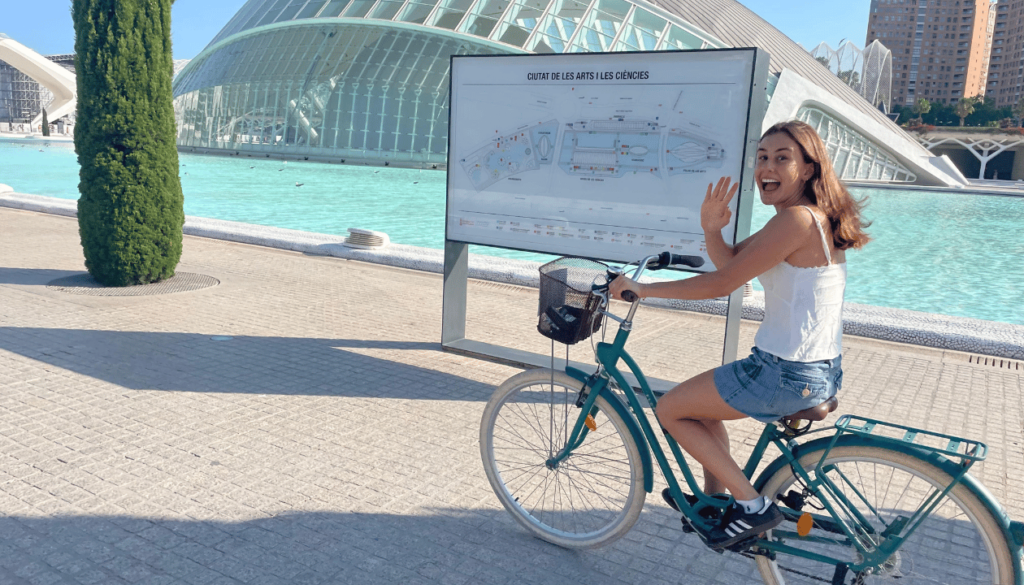
The girls asked questions in Spanish about everything they saw, from the art installations in the gardens to the types of trees lining our path. It became a moving classroom on wheels – they were absorbing knowledge and new words effortlessly while on the go. The ride ended at the beach, where we were greeted by a refreshing sea breeze and golden sand. There, we took a break and continued our conversations about culture and travel, all in Spanish.
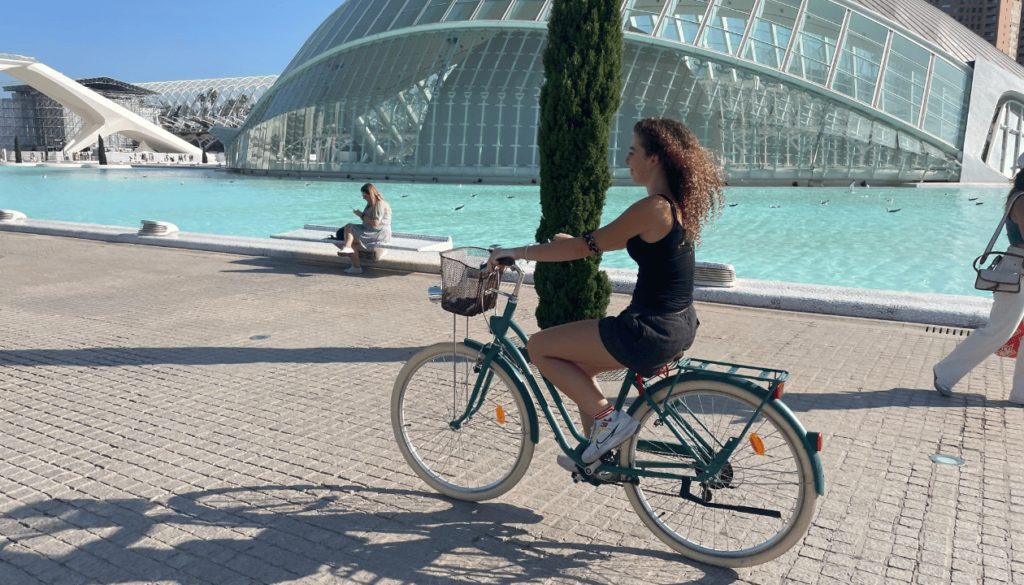
By combining physical activity with language practice, the girls saw how learning and fun can go hand in hand. The bike tour not only gave them a bit of exercise but also expanded their understanding of Valencia’s blend of urban and natural landscapes.
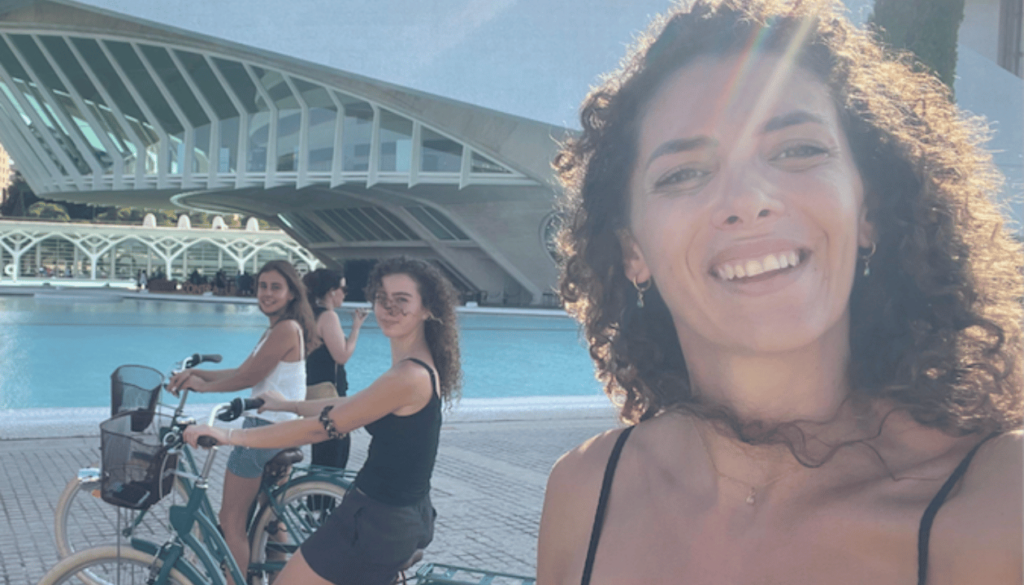
Visit to the Navajas Waterfall
For a change of scenery, I organized a day trip outside the city to visit the Navajas Waterfall (Salto de la Novia), a breathtaking natural spot a short drive from Valencia. This excursion was a favorite for Sofía and Flora, as it combined adventure with relaxation.
We hiked along a picturesque trail to reach the waterfall, chatting and laughing in Spanish the whole way. Surrounded by stunning views of water cascading down and lush greenery, the girls couldn’t help but express their awe (in Spanish, of course!). We took plenty of photos and even taught each other some nature-related vocabulary – words like cascada (waterfall) and rocas (rocks) became part of their lexicon.
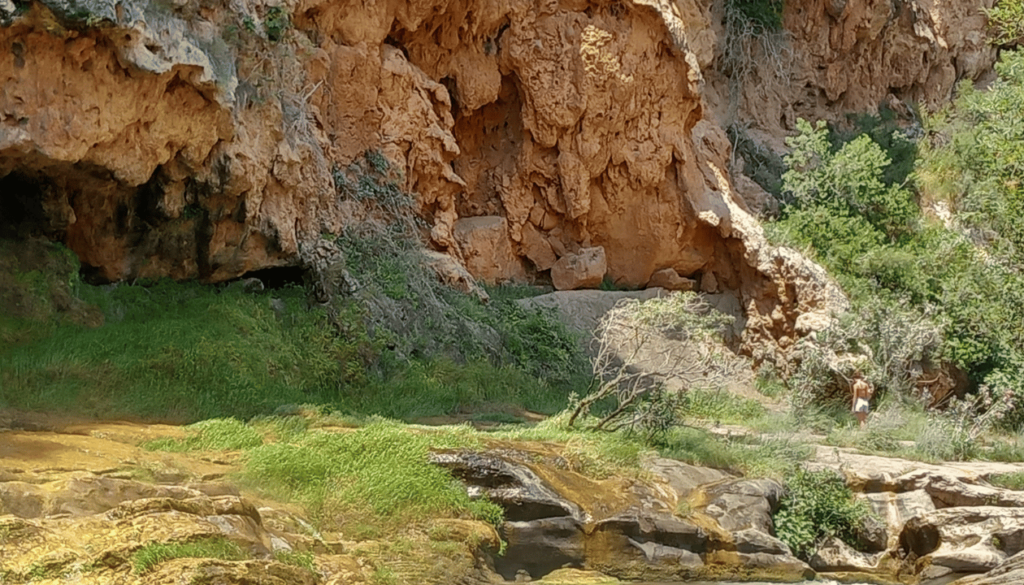
After the walk, we enjoyed a packed lunch near the falls, where conversation flowed freely about travel and nature. This outing was special because it was so different from the typical tourist spots; it gave them a taste of Spain’s natural beauty and a serene environment to practice speaking. I could tell that exploring the outdoors put them at ease, which made their spoken Spanish even more fluent and unselfconscious.
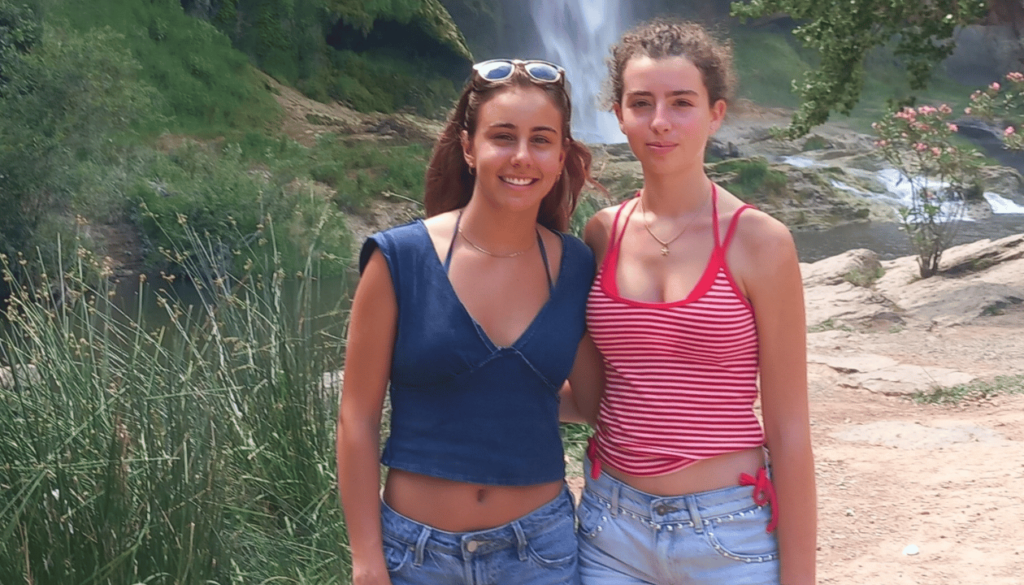
Exploring Valencia’s Historic Center
No trip to Valencia would be complete without exploring its historic heart. On another day, we headed into the city’s old town to soak up some history and culture. We visited landmarks like La Lonja de la Seda (the Silk Exchange), the grand Central Market, and the charming Plaza de la Virgen. As their tutor-guide, I shared stories about each site, all in Spanish, of course, which turned our sightseeing into an interactive history lesson.
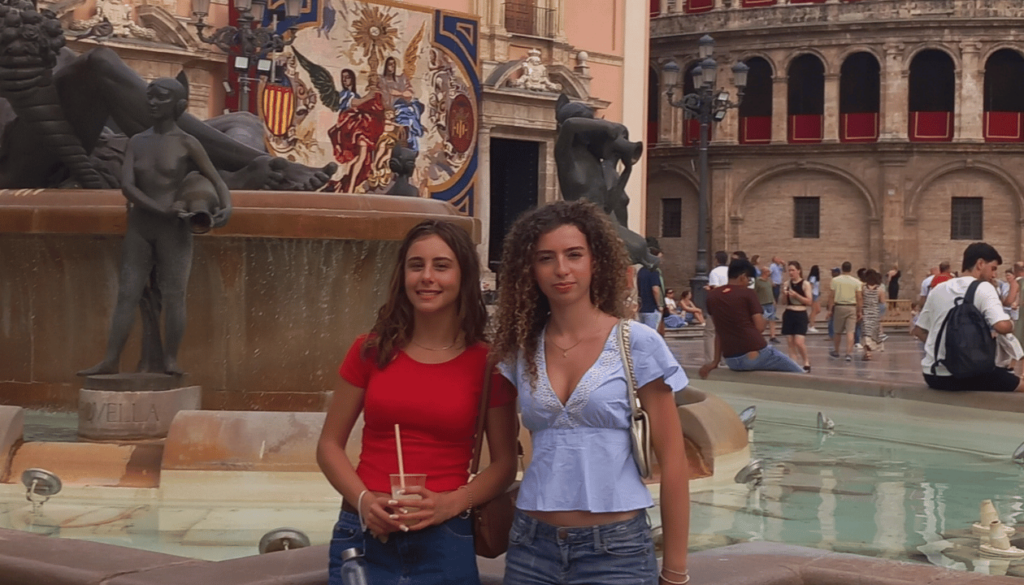
Sofía and Flora were amazed by the architecture and asked great questions, practicing the art of description and comparison in Spanish. For example, they described how the gothic style of La Lonja differed from the modern buildings they’d seen earlier, using adjectives they had learned in our lessons. A fun highlight of this city tour was when we arrived at Plaza de la Reina near the Cathedral. The girls spontaneously decided it was the perfect backdrop for a mini photo shoot.
They took turns being photographer and model, giving each other directions in Spanish (like “¡Sonríe!” meaning “smile!”) and laughing throughout. This playful moment showed how comfortable they had become – they were using the language casually among themselves without any prompting from me. By the end of the day, they had not only deepened their understanding of Valencia’s history and heritage but also reinforced their confidence in speaking Spanish in public settings.
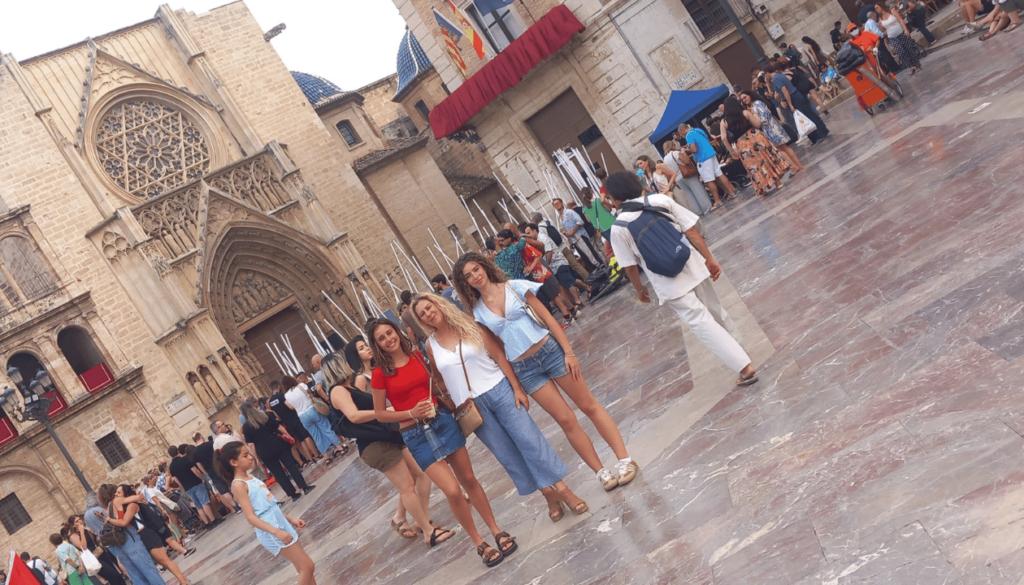
A Day at Home: Gilet Walk, Relax & Pool Time
Amid all our excursions, we made sure to enjoy some downtime at home as well. One morning, we took a leisurely walk through my village of Gilet, giving the girls a glimpse of everyday life in a small Spanish community. We greeted neighbors, observed local shops opening for the day, and talked about how life in a Valencian village compares to their own hometowns. Back at home, the afternoon was all about relaxation. We spent time by the pool in my backyard, chatting naturally in Spanish in a laid-back family environment.
There was no formal lesson plan for this part of the day, just spontaneous conversation and bonding. These relaxed moments were important because they allowed Sofía and Flora to use Spanish in a very informal, comfortable context, much like friends hanging out. They realized that language isn’t only for formal scenarios or travel; it’s also for everyday sharing of thoughts and jokes. By the end of our pool time, I noticed how seamlessly they switched between joking around and expressing more complex ideas in Spanish, a sign that fluency was really taking hold. Sometimes, a bit of rest and routine at home can teach you as much as a day out in the city!
San Juan Night Celebration at Port Saplaya
One of the most magical experiences of their stay happened on the night of San Juan (June 23rd). San Juan is a famous celebration in Spain that welcomes the summer, and we weren’t going to miss it! That evening, I took Sofía and Flora to Port Saplaya, a charming beach area just outside Valencia, to join the festivities.
The atmosphere was electric: bonfires dotted the beach, music played in the background, and families and friends gathered all around. We shared this special night with my host family and a few friends, which made the girls feel like part of the community. As per tradition, at the stroke of midnight, we all participated in the ritual of jumping over seven small waves for good luck.
Sofía and Flora were delighted (and a little nervous) to do it, but they jumped right in literally! laughing and making seven wishes for the future as they leapt through the waves. All our conversations and cheers were in Spanish, naturally, and the girls learned a few fun idioms connected to the night’s traditions. This celebration was a crash course in Spanish culture and tradition. It immersed them in the joyous spirit of a Hispanic festival, something you can’t experience through any textbook or exam paper.
Dinner by the Beach on San Juan Night
After the San Juan rituals, we all sat down at a seaside restaurant to enjoy a late-night dinner by the Mediterranean waves. Tasting local dishes with the salty sea breeze in the air was an experience in itself. Over dinner, we continued to speak in Spanish about everything we had seen and felt that night. We talked about Mediterranean cuisine, compared it with some Italian dishes the girls knew, and discussed how celebrations in Spain might differ from those in Italy or the USA.

This kind of cultural comparison deepened their understanding of how traditions shape people’s values. It also broadened their perspective on the Hispanic world as part of a global mosaic. The girls remarked how the society here values family time and community gatherings, similar in some ways to Italy. By the end of the meal, we were not just teacher and students, but friends sharing stories across cultures. That sense of human connection, la convivencia at its best, made the language come alive in a meaningful way.
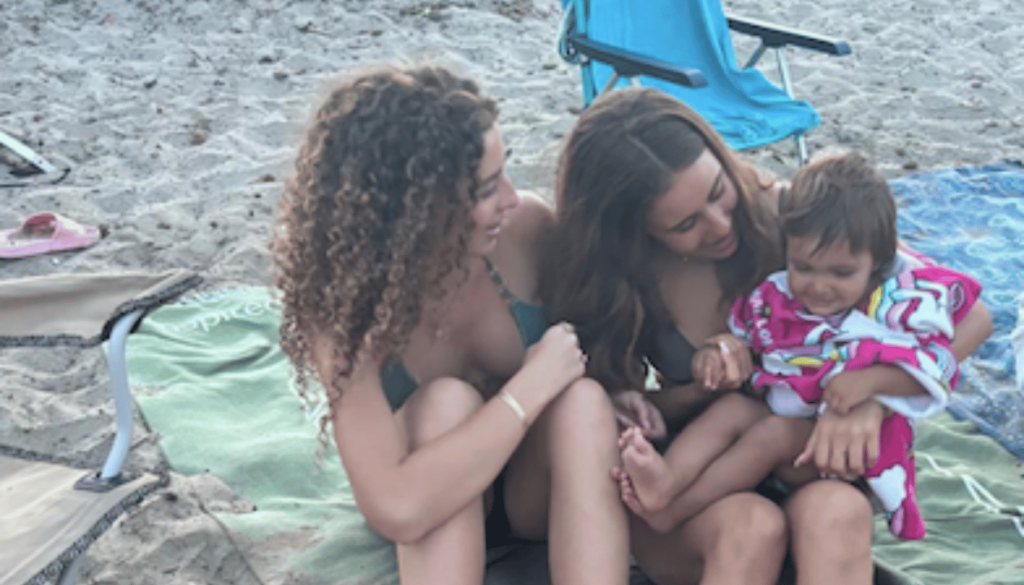
Sports Activity: Tennis in Spanish
Being active is a wonderful way to learn, and we made sure sports were part of the itinerary. Both Sofía and Flora are quite sporty, so I arranged a couple of tennis sessions with Tanja, a professional instructor (and friend of mine) who was thrilled to coach them in Spanish. On the tennis court, the usual drills and games turned into dynamic language lessons. Tanja introduced tennis terms and gave instructions entirely in Spanish. At first, the girls found it challenging to keep up with the vocabulary while also focusing on their swings and footwork. But soon they got the hang of it – ¡dale! (“go for it!”) and ¡bien jugado! (“Well played!”) became common phrases during the match.
There was plenty of laughter every time someone missed a shot or learned a funny new word. Sports have a way of breaking down language barriers, and here it made Spanish the natural medium for teamwork and friendly competition. By conducting the session in Spanish, the girls realized they could integrate language into any activity. This experience boosted their listening comprehension (since they had to react quickly to instructions) and showed them that learning can happen even when you’re running around and having fun. It was a perfect example of how you can develop fluency in unexpected settings outside a traditional lesson.
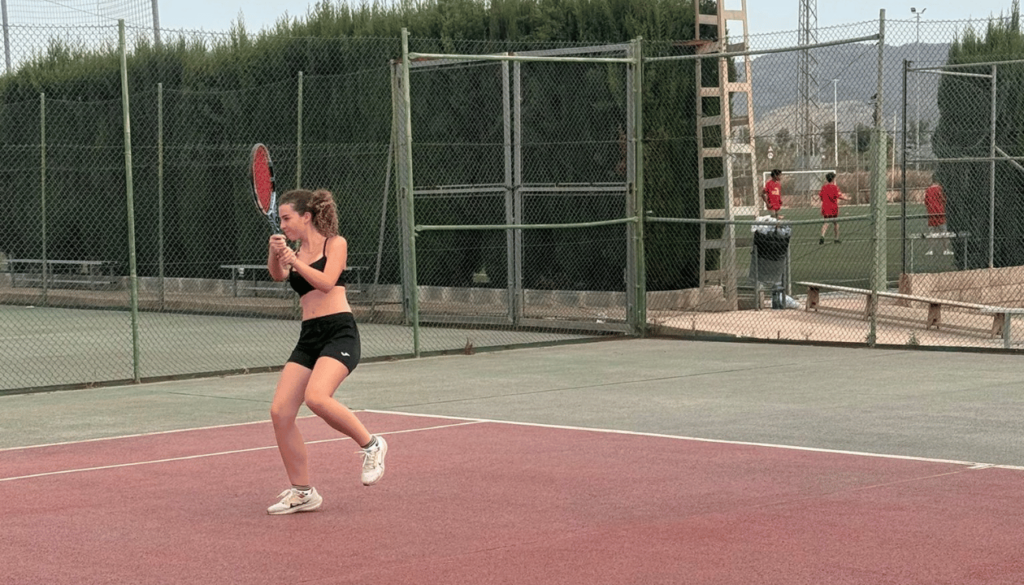
Visit to the San José Caves in Vall d’Uxó
Mid-week, we went on an adventure to the Cuevas de San José in Vall d’Uxó – home to the longest underground river in Europe. This was an extraordinary outing that combined nature, science, and a bit of thrill. We took a guided boat ride through the caves, gliding on clear waters beneath spectacular rock formations. As we floated in near silence (so as not to disturb the cave’s tranquility), the guide explained the geology and history of the caverns in Spanish.
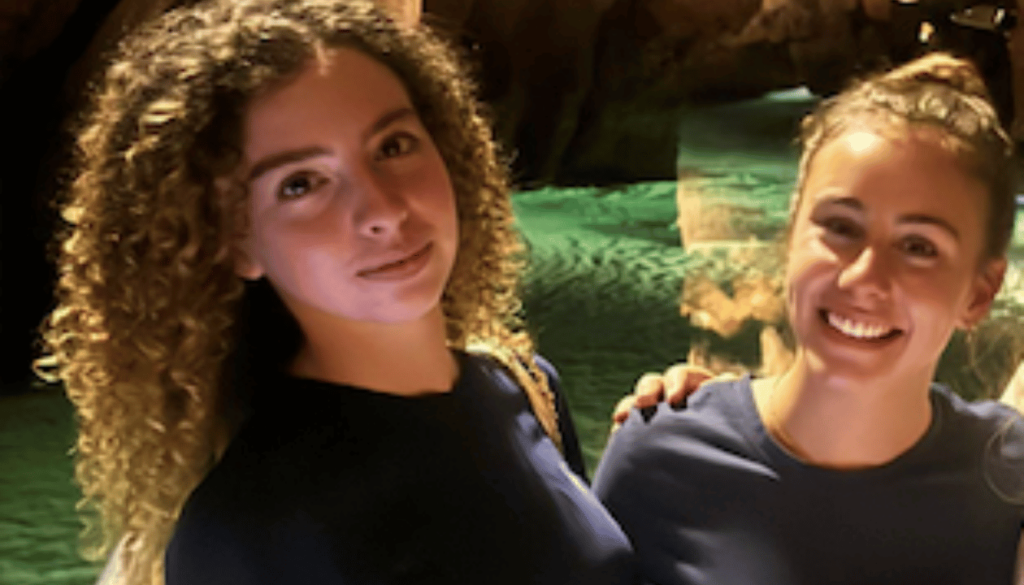
I quietly translated a few technical terms when needed, but for the most part, Sofía and Flora followed along and understood the Spanish commentary very well. After days of immersion, their listening skills were sharp! After the boat ride, we explored the area around the cave entrance, discussing what we learned. We chatted about how the caves formed, throwing around new words like estalactita (stalactite) and estalagmita (stalagmite).
This visit was not only a science lesson but also an unusual way to reinforce language learning. The girls were intrigued by the natural wonder and proud that they could grasp the explanations in Spanish. It proved to them that their effort in studying vocabulary and doing listening practice had paid off. Experiences like this build confidence, as they realize they can handle Spanish even in situations filled with specialized terms.
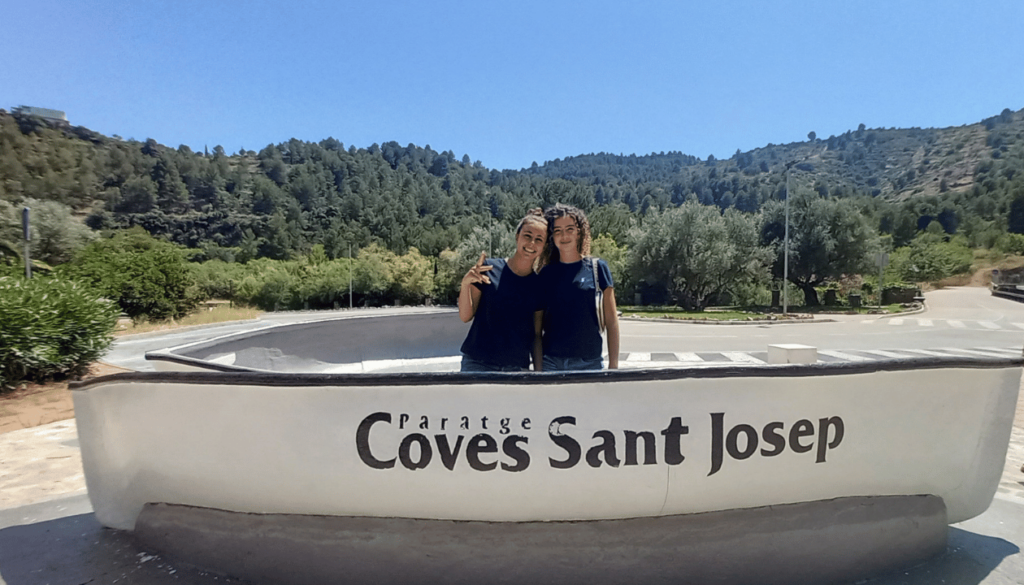
Sunset at La Albufera Lake
To cap off an incredible week, I planned an evening trip to La Albufera, a peaceful lake just south of Valencia, famous for its sunsets. We went along with my friend Esmeralda again, making it a cozy little group. As the sun began to dip, we boarded a small wooden boat for a serene ride on the lake. The sky turned brilliant shades of orange and pink, reflecting on the calm waters – it was truly magical.

Sitting on the boat, we all spoke in Spanish about the highlights of the week, sharing what we each loved most about the experience. It was heartwarming to hear Sofía and Flora articulate their thoughts and feelings so naturally in their second language. They took stunning photos of the sunset to show their families and perhaps to use in their school presentations later. Watching them gaze at the horizon, I felt a swell of pride.
In just a short time, these students had grown more confident, curious, and capable in Spanish. The aspects of language that felt hard on day one, like listening to fast conversations or speaking up, were now part of their comfort zone. As the last light faded, I knew this was an unforgettable moment for all of us. It beautifully symbolized the closing of their immersion journey: bright, serene, and full of hope for the future.
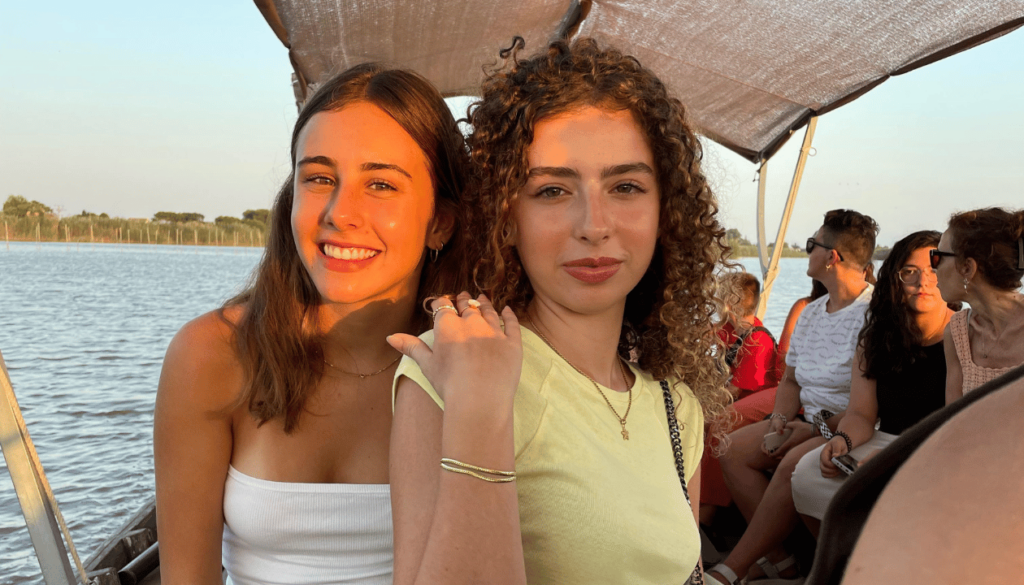
A Rewarding Journey and Future Steps
By the end of their stay, Sofía and Flora had made remarkable progress. Not only did they significantly improve their spoken Spanish, but they also gained a deeper understanding of Spanish life and culture. They left Valencia with increased fluency, new friends, and countless memories. I was especially happy to see them express themselves with such ease – a big change from when they first arrived a week prior, a bit shy to speak. Their hard work throughout the immersion really paid off. They are now better prepared to tackle their A-level Spanish exams with confidence. In fact, we even went through some past papers and reviewed mark schemes together, so they know exactly what to expect in the exam and how to excel.

As a host teacher and tutor, I find experiences like this incredibly fulfilling. Seeing my students grow in knowledge and confidence is the best reward. Programs like SHIP allow learners to step beyond textbooks and truly live the language. This approach complements formal education and helps prepare them for whatever comes next – be it further examinations and qualifications, university studies, or even careers where bilingual skills are an asset. I have no doubt that Sofía and Flora will carry forward the skills they honed here, whether in further studies or in their everyday lives. Sofía mentioned she might pursue Spanish at a degree level at university, and Flora is excited to continue improving and maybe even study abroad someday. Both girls will soon be applying to universities, and their newly gained language skills will surely give them an edge in whatever they choose to study. Whatever path they choose, their ability to communicate in Spanish will open doors, perhaps in international business, law, education, or simply connecting with people across cultures.
Hosting Sofía and Flora reminded me why I love teaching. With the right resources and an immersive environment, students can achieve more than they initially expect. Both girls embraced every challenge, from grammar drills to speaking with strangers, showing that learning a language is so much more than just passing exams or doing well in assessments. It’s about building bridges to another culture and gaining a broader perspective of the world.
Join me for a 1 to 4 Week Spanish Immersion?
For anyone considering improving their Spanish or preparing for an exam like A-level, I highly recommend an immersion experience. At Spanish Express, we even offer flexible scheduling and monthly instalments to help more learners take part in programs like this. There’s a reason we continuously update our methods and introduce new courses at Spanish Express – because language learning is a living, breathing journey. In a program like this, students don’t just study Spanish; they live it. And as Sofía and Flora’s journey in Valencia shows, living the language is truly the fastest way to fluency and success.
¡Hasta pronto! (See you soon!) I look forward to maybe welcoming them back or meeting other enthusiastic learners in the future. Every student leaves a mark, and with each homestay, I also learn something new. Their adventure in Valencia as friends was a beautiful example of cultural exchange and personal growth. It was an absolute pleasure to teach Sofía and Flora and witness their transformation. The result? Two confident young speakers who are ready to conquer the Spanish-speaking world with their newfound skills and a lifetime of memories.

